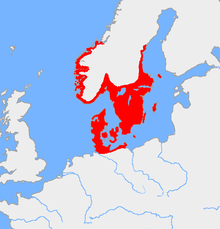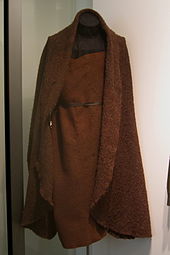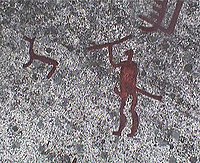Nordic Bronze Age
|
|
This article or section was due to content flaws on the quality assurance side of the Bronze Age project entered. This is done in order to bring the quality of the articles from this topic to an acceptable level. Please help to fix the shortcomings in this article and join the discussion ! |
According to Oscar Montelius (1843–1921), the Nordic Bronze Age (1800 BC - 530 BC) is an epoch of the Bronze Age in southern Scandinavia , the sites of which range from Denmark and northern Germany to Estonia .
The Nordic Bronze Age was preceded by the Neolithic Dagger Age (stone box phase) , which is particularly known in southern Scandinavia . It was followed by the pre-Roman Iron Age and finally, depending on the historical classification, the “ Germanic Iron Age ”, the Roman and post-Roman Iron Age or the Vendel Age (550–800) and then the Common Scandinavian Viking Age (800–1050).
Periodization
| Nordic Bronze Age | |||
| Nordic Late Bronze Age | Period VI | 550/530 B.C. 730/720 BC. |
|
| Nordic Younger Bronze Age | Period V | 730/720 BC. 950/920 BC |
|
| Period IV | 950/920 BC 1100 BC |
||
| Nordic Elder Bronze Age | Period III | 1100 BC 1300 BC |
|
| Period II | 1300 BC 1500 BC |
||
| Period I. | 1500 BC 1800 BC |
||
The Nordic Bronze Age is divided into periods I-VI according to the system created by Oscar Montelius (1843–1921) Om tidsbestämning inom bronsåldern med särskilt avseende på Scandinavia ( 1885 ) . The term Bronze Age is not used for Northern Scandinavia, but the Metal Age .
General characteristics
The Scandinavians got to know bronze relatively late through trading, as Scandinavia did not have its own copper deposits. The southern Scandinavian sites show rich and well-preserved objects made of wood, wool, gold and (imported) bronze. The organic substances are mainly preserved in depot and individual finds, which mostly come from moors and bodies of water, as well as in the barrows , the chambers of which in some cases offered good conservation conditions (tree coffins). When looking at the burials, it is also noticeable that bronze weapons and jewelry could only be found in the large burial mounds, while the tombs of the common people only contained rock and flint tools.
The Scandinavians adapted many central and southern European symbols at the time they were developing new styles and objects themselves. The amber trade is assumed to be the cause of the foreign influence. Amber found in Mycenaean tombs from this period comes from the Baltic Sea . It therefore seems logical to recognize the provider of the so-called Amber Road in the culture that appeared in the Nordic Bronze Age . Engravings in metal, petroglyphs and the large stone settings known as ship settings show that seafaring played a role in the Baltic Sea. But an exchange can also be seen in the other direction; a Mycenaean spout was found in Dohnsen in Lower Saxony.
From this time earth and stone mounds, roses , stone boxes and rock paintings have been preserved. Some petroglyphs have been dated to the Nordic Bronze Age by comparing depicted objects with archaeological finds. Bronze axes were also depicted as petroglyphs. The first archaeologist to recognize this connection was Oscar Montelius. There is also a group of petroglyphs that can be assigned to the northern hunter culture, which mostly depicts moose .
climate
Claims that (not only) the Nordic Bronze Age should be characterized by a warm climate persist, but have so far not been conclusively proven.
Due to climate change and the Iron Age population loss ( Cimbri and Teutons ), the Nordic cultures passed through towards the end of the Bronze Age around 600 BC. A cultural decline that lasted about 800 years until the rise of the next, advanced civilization, indicated by the centers of wealth ( Gudme ), which began before the Viking Age .
Arts and Culture
In Sweden, around 10,000 places with several hundred thousand rock carvings are known from the Bronze Age . The pictures were carved into the rocks with a very hard stone. It has not been established whether the incisions were painted - as they are today. The most famous sites in Scandinavia are the rock carvings by Tanum .
Large musical instruments are a noticeable item from the Bronze Age. These trumpet-like horns, also called lurs , were mostly found in pairs in moors. The cultural significance of the Lurs is underlined in particular by the depiction of Luren blowers in rock art.
religion
In the absence of written sources, not much is known about the religions of the Nordic Bronze Age. Yet many archaeological finds give a vague picture of the faith.
Most scientists assume that the sun or a sun god stood in the middle of the Nordic Bronze Age religion. It is also assumed that a pair of twins was worshiped by gods , which is said to be reflected in the duality of sacred objects: where these were sacrificed to the earth (found by Mariesminde ), they are often found in pairs. Furthermore, a female goddess (or mother goddess ) was probably worshiped (see Nerthus ). Animals, weapons, jewelry and people, as far as can be determined, were often sacrificed in connection with water. Often small bogs, lakes or ponds were used as sacrificial sites, which is why many artifacts are found in such places. Hierogamy rites are depicted on rock carvings, so they were common.
It is believed that contents of the Bronze Age religion and mythology continue to exist in Germanic and Nordic mythology , e.g. B. Skinfaxi , Hrimfaxi Sleipnir and Njörd .
See also
literature
- Evert Baudou: The regional and chronological division of the younger Bronze Age in the Nordic Circle (= Studies in North-European archeology. 1, ZDB -ID 190077-8 ). Almqvist & Wiksell, Stockholm et al. 1960, (At the same time: Stockholm, University, dissertation, 1960).
- Jan Dąbrowski: Nordic Circle and Cultures of Polish Territories. In: Björn Ambrosiani (ed.): The bronze age in the Baltic Sea region. A report from the Kgl. Swedish Academy of Literature, History and Antiquity Research through the Julita Symposium 1986 (= Kungl. Vitterhets Historie och Antikvitets Academies. Konferenser. 22). Almquist & Wiksell, Stockholm 1989, ISBN 91-7402-203-2 , pp. 63-82.
- Emilienne Demougeot: La formation de l'Europe et les invasions barbaren. 2 volumes (in 3). Aubier, Paris 1969-1979.
- Markus Egg , Christopher Pare : The metal times in Europe and the Middle East. The prehistory department in the Roman-Germanic Central Museum (= catalogs of prehistoric antiquities. 26). Publishing house of the Roman-Germanic Central Museum, Mainz 1995, ISBN 3-88467-035-2 .
- Lars Ivar Hansen, Bjørnar Olsen: Samenes historie fram til 1750. 3. Opplag. Cappelen, Oslo 2007, ISBN 978-82-02-19672-1 .
- Different Kaliff: Gothic Connections. Contacts between eastern Scandinavia and the southern Baltic coast 1000 BC - 500 AD (= Occasional Papers in Archeology. 26). Uppsala University - Department of Archeology and Ancient History, Uppsala 2001, ISBN 91-506-1482-7 .
- Oscar Montelius : Om tidsbestämning inom bronsåldern med särskilt avseende på Scandinavia (= Kungl. Vitterhets, Historie och Antikvitets Akademiens handlingar. Del 30 = NF 10, ZDB -ID 953008-3 ). Kongl. Boktryckeriet, Stockholm 1885, ( digitized ).
- Lucien Musset : Les invasions. Les vagues germanique (= Nouvelle Clio. 12, ISSN 0768-2379 ) Presses universitaires de France, Paris 1965.
- Ingemar Nordgren: The Well Spring Of The Goths. About the Gothic Peoples in the Nordic Countries and on the Continent (= Scriptures from Västergötland's Museum. 30 = Historieforum Västra Götaland. Series A: Academic Dissertations. 1). iUniverse, Inc., New York NY et al. 2004, ISBN 0-595-33648-5 .
Web links
- Literature about the Nordic Bronze Age in the catalog of the German National Library
- www.bronzeage.net ( Memento from February 21, 2009 in the Internet Archive )
Individual evidence
- ^ A b c Egg, Pare: The metal times in Europe and in the Middle East. The prehistory department in the Roman-Germanic Central Museum (= catalogs of prehistoric antiquities. 26). Publishing house of the Roman-Germanic Central Museum, Mainz 1995, ISBN 3-88467-035-2 , p. 64.




